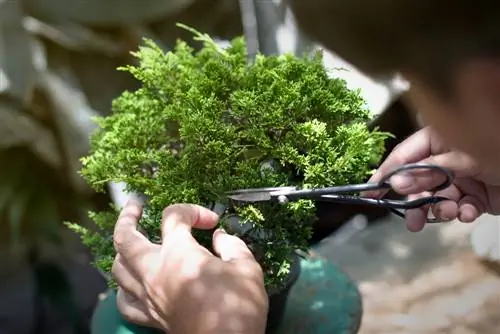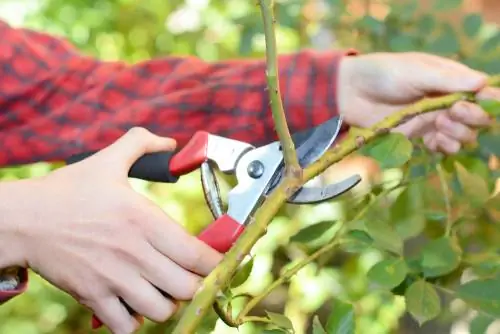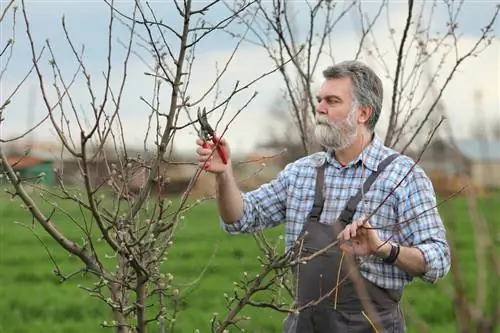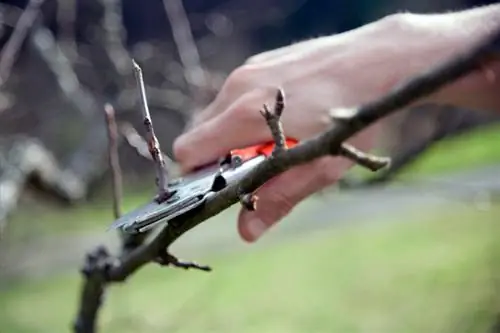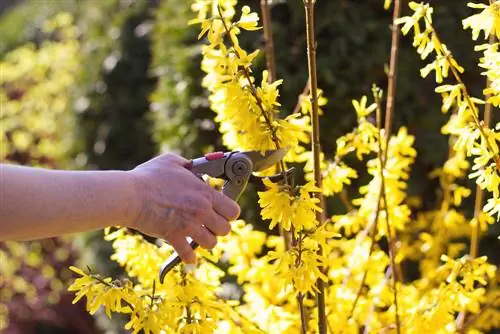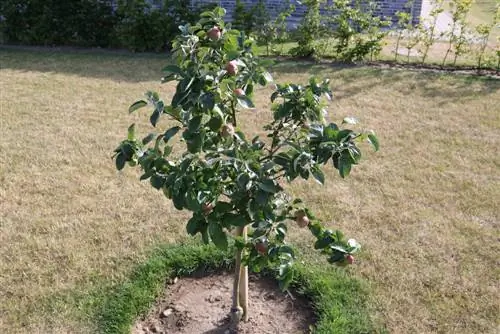- Author admin [email protected].
- Public 2023-12-26 14:17.
- Last modified 2025-06-01 06:02.
A wise master in the art of bonsai once said: “Bonsai is not a plant species or an achievable goal, but a never-ending journey”. On this journey to create a representative mini tree, the gardener always has scissors and pliers at hand. Correct cutting plays a key role in professional bonsai care. This tutorial is made for beginners to Asian garden art. Here you can read everything you need to know about pruning indoor and outdoor bonsais.
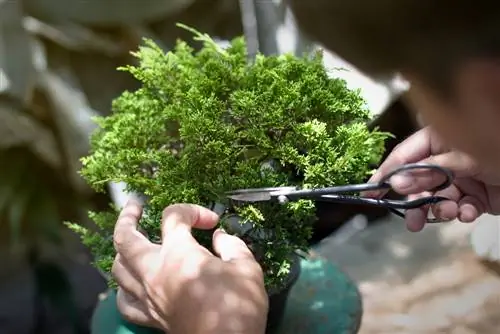
What is a bonsai? - Overview for beginners
In translation, the Chinese characters for bonsai mean “tree planted in a shallow bowl”. In Japan, bonsai lovers prefer the short version “tree in a bowl”.
The art of bonsai design has been celebrated in China and Japan for more than a thousand years. In Europe, the Asian art form is captivating more and more private gardeners. The aim of bonsai art is to create a realistic,lifelike image of a tree in mini format. In fact, bonsais are not genetically dwarf trees. In fact, almost any type of tree can be designed as a bonsai. The range of bonsai sizes is correspondingly large. A uniform classification according to size is not yet available. After all, the following list provides an overview of the wide range of recognized size classifications:
- Keshitsubo: 3 to 8 cm
- Shito: 5 to 10 cm
- Mame: 5 to 15 cm
- Shohin: 13 to 20 cm
- Komono: 15 to 25 cm
- Katade mochi: 25 to 45 cm
- Chumono/Chiu: 45 to 90 cm
- Omono/Dai: 91 to 130 cm
- Hachi-uye: 102 to 152 cm
- Imperial: 152 to 203 cm
The sizes are fluid for a reason. According to traditional classification, a bonsai size is rated based on how many men are necessary to support the tree.
Cut bonsai correctly - with these types of cuts you can do it
The wide range of bonsai sizes signals that Asian garden art focuses on diverse aspects that go far beyond height growth. Aharmonic balance of shell, roots, trunk, branches and leaves is essential for an authentic design. The perfect bonsai presents itself with a balanced ratio between the plant bowl and the crown circumference. The narrow bowl is primarily aimed at promoting the tree's squat growth. Proper pruning care makes a valuable contribution to ensuring that the crown does not become too voluminous, the trunk does not become too thick and the leaves do not become too large. The following table summarizes which types of cutting keep the pot and bonsai in balance:
| Cut style | Target | Appointment for garden bonsai | Appointment for room bonsai |
|---|---|---|---|
| Care and maintenance cut | maintain compact growth and shape | June to September | Spring to Autumn |
| Design cut | Modeling a basic bonsai shape | early spring (February to April) | Late autumn or early spring |
| Leaf or needle cutting | targeted reduction of leaf or needle size | June to mid-July | June to mid-July |
| Root cutting | Modification of root volume to bowl size | after each repotting | after each repotting |
For the correct cutting time on the garden bonsai, please take the localweather conditions into account. Do not cut an outdoor bonsai in frost, strong heat or direct sunlight. Ideally choose a day with mild temperatures and overcast skies.
Prune flowering bonsai plants in accordance with the flowering period. Spring-flowering species should only be pruned after the flowering period. On summer-flowering trees, however, the scissors are used in late winter or early spring. Evergreen indoor bonsais make choosing a date easy for the gardener, as the mini trees tolerate light care and maintenance pruning at any time. However, more extensive design cuts should be planned for February or March.
Background
Understanding how a tree grows paves the way to the perfect bonsai cut
The growth law of tip promotion teaches the bonsai gardener that trees transfer all their energy into the buds at the tips of the shoots. Because these areas are the quickest places to rise and reach light, lower-lying buds and shoots are supplied with so little nutrients that they die. This process is undesirable for the design of bonsai trees and affects the design work. Pruning shoot tips slows down the process of tip promotion and diverts the reserve substances to buds and branches positioned further down and inside the crown. With every cut, remember that you trigger a growth effect that significantly influences the design.
Instructions for care and maintenance cutting
With regular pruning you can maintain and refine the representative appearance of your bonsai. As explained in our background information, top growth naturally dominates in every tree. The main task of care and maintenance pruning is the targetedremoval of tip buds in order to stimulate growth inside the crown. How to proceed professionally:
- Deciduous trees: cut off shoots that protrude from the shape and grow into the inside of the crown
- Cutting technique: Place bonsai scissors just above an outward-facing bud
- Coniferous trees: awkwardly positioned branches and coniferous bushesdon't cut, but pluck
- Plucking technique: Hold the tip of the shoot to be shortened between your index finger and thumb and break it off
- Alternatively, use tweezers to remove unwanted shoots and needles
On coniferous trees such as pine, yew or stone yew, leave only the outer needle tufts on selected side branches. All excess secondary branches are removed. The care and maintenance pruning of conifers is also dedicated to this year's shoot candles, which are also broken out with the fingers. The reason for the special procedure is to avoid brown needle tips after a cut from the bonsai scissors.
Design cutting instructions - on the way to the perfect shape
With the design cut you give your bonsai itsbasic shapeAs part of the pruning design, large branches sometimes have to be removed at the beginning. Undoubtedly, beginners find the radical approach difficult because final decisions have to be made as to which shoots to cut out and which to preserve. The following instructions cannot make this decision for you, but only explain the correct procedure:
- The best time is in spring, well before the start of the growing season
- Position the tree at eye level and put tools (bonsai scissors and concave pliers) within easy reach
- First remove all dead and dry shoots, including dried leaves
- Take a few steps back and plan each furtherEdit
- Of two competing branches, thin out the weaker one
- Remove vertical, inside the crown and unnaturally twisted branches
- Cut off all shoots that cross the front of the trunk
The basic rules for exemplary design pruning include removing thick branches in the upper crown area. For a natural appearance, the branches at the bottom should have a larger diameter than branches near the top of the tree.
Excursus
Wiring and bending completes the skillful bonsai cut
Regular cutting alone does not achieve the desired bonsai shape. If you combine thecuttingwith artisticwiring and bending, your mini tree will gradually take on the desired shape. Aluminum wire in thicknesses of 1 to 8 millimeters is perfect because it is easier to process than copper wire. To regulate individual branches in the direction of growth, use a wire thickness that corresponds to aof the branch thickness. First, cut the appropriate length of wire. Wrap the wire twice around the trunk or leading branch at a 45 degree angle and continue working along the branch to the tip of the branch. If several wires extend from the trunk or leading branch to the respective branches, make sure that they run neatly, parallel next to each other and not on top of each other. Only when all the branches on the tree have been wired will each individual shoot be bent.
Leaf cutting instructions
Leaf pruning is a special type of pruning that aims atreduced leaf sizeand increased branching. For this purpose, cut off all leaves in summer. The technique is only practiced onhe althy, vital deciduous trees that can tolerate such a strenuous procedure. Alternatively, you can use leaf pruning to slow growth in selected tree areas. To do this, for example, defoliate the upper half of the crown and leave the leaves in the lower part. How to do it right:
- Best time is from June to mid-July
- Use sharp scissors to cut off leaves (all or certain parts of the tree)
- Important: leave the leaf stem standing
- Place the pruned bonsai in partial shade for 4 weeks
Please only use leaf pruning on a he althy tree that is suitable for the pruning type. If in doubt, please ask your trusted bonsai tree nursery.
Tip
Your bonsai can only handle one major cut per year. Therefore, please do not combine a design or leaf cutting with repotting into a new bowl. Postpone the change to fresh substrate and the associated root pruning until next year or wait until the tree has recovered.
Balance between root ball and crown - root cutting instructions
An important component of your bonsai is its Nebari, or root base. In the limited volume of a bonsai pot, the surface roots have the task of visual and factual stabilization. Regular pruning of large, vertical roots shifts growth to the lateral root strands. As a result, these roots become thicker over the years and form a natural-looking Nebari. How to do it correctly:
- The best time to repot is in early spring
- Unpot the bonsai and remove the old substrate
- Cut off long, vertically downward roots using scissors or root pliers
The thicker a root, the stronger the pruning. Thin rootsonly prune thetips In this way you promote the formation of a dense system of fine roots so that your bonsai is sufficiently supplied with nutrients despite the small amount of substrate. Plant the tree in fresh substrate and water. For the next 3 to 4 weeks he can recover from the strain in a partially shaded location.
Five basic bonsai shapes for beginners - inspiration for cutting design
Over the course of almost two thousand years of development, a variety of bonsai design forms have emerged that are predestined for entry into Asian garden art. Be inspired by the following five basic shapes:
Broom Shape Bonsai (Hokidachi)
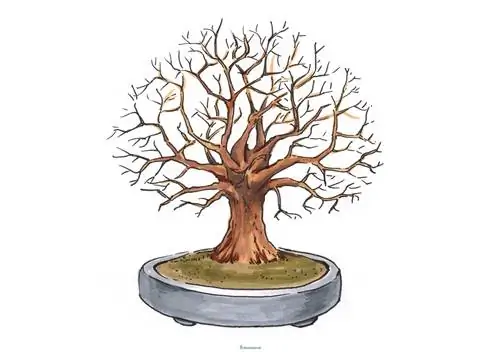
Deciduous trees with delicate branching look great as broom-shaped bonsai. The straight, upright trunk does not go all the way to the top of the tree, but branches in all directions to form a round crown.
Strictly upright bonsai shape (Chokkan)
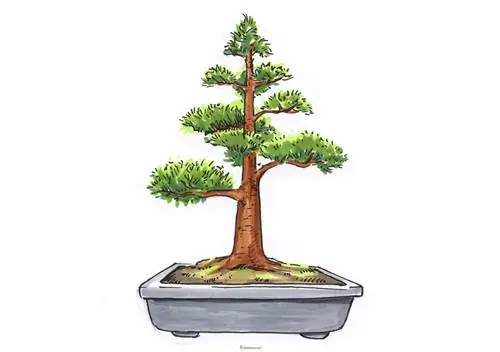
The strictly upright bonsai shape is recommended for indoors and outdoors. Ideally, the trunk grows thicker at the base and tapers toward the crown. A single branch serves as the tip because the trunk does not extend to the entire height of the tree.
Literati bonsai form (Bunjingi)
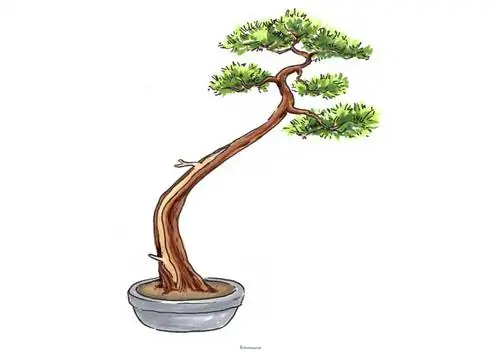
The literary bonsai form is considered a reflection of nature. Where trees are in fierce competition with one another, they grow as high as they can and only have a small crown at the top.
Forest bonsai shape (Yose-ue)
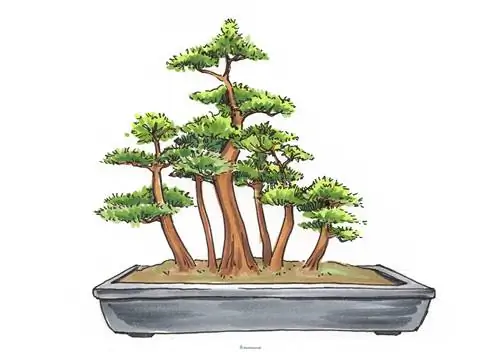
The advantage here is that the relatively young trees create the impression of a primeval forest. The thickest and tallest main tree is in the center of the background, surrounded by smaller trees that form a common canopy. An uneven, moss-covered floor enhances the natural appearance.
Rock shape over stone (Seki-joju)

In the mountains, trees are often forced to send out their roots in search of nutrient-rich soil. The roots run unprotected over rocks until they reach the ground. As a bonsai, the root strands grow over a stone into the substrate. The care does not differ significantly from other basic forms.
Recommended tree species for indoors or outdoors
Theoretically, all trees are suitable for bonsai design. With a view to varying levels of pruning tolerance, various tree species have emerged as being particularly recommended for bonsai design. Below we introduce you to the best deciduous and coniferous trees for beginners in the art of bonsai:
Fig trees (Ficus)
A good-natured pruning tolerance has catapulted fig trees to one of the top places in the ranking of recommended bonsai species. There are more than 800 species to discover the right Ficus for every plant lover. Evergreen fig trees are native to tropical regions, making them suitable for cultivation in living spaces. The public's favorite is the birch fig (Ficus benjamina), which grows to 200 to 500 centimeters tall without pruning. The slightly wavy, shiny green ornamental leaves, which are naturally small in stature, are decorative.
Chinese juniper (Juniperus chinensis)
A slight toxic content does not prevent Chinese juniper from establishing itself as a popular garden bonsai. Its most beautiful decoration is the scale-shaped foliage, which shimmers yellow-green, blue-green or gray-green. The pure species and all varieties resulting from it can remain in the garden all year round. As with all conifers, regular care and pruning should focus on the needled area.
Maple (Acer)
Bonsai gardeners can choose from a variety of maple species. The picturesque varieties of Japanese maple (Acer palmatum) are very popular for the stylish interpretation of Asian garden art. The trees remain small by nature and delight with their furious leaf colors and spectacular autumn foliage. The trees are completely hardy and decorate the garden and balcony all year round.
Rhododendron, Azalea (Rhododendron species)
Do you want a garden bonsai with picturesque flowers? Then the Rhododendron genus comes into focus. Among more than 1000 species, Satsuki azaleas (Rhododendron indicum) and Kurume azaleas (Rhododendron kiusianum) have particularly stood out for cultivation as bonsai. In contrast to their big sisters, bonsai azaleas are easy to cut. It is important to note that the cutting date is after the flowering period so that the flower buds that have been planted do not fall victim to the scissors.
Pine (Pinus)
Many gardeners consider Japanese black pine (Pinus thunbergii), mountain pine (Pinus mugo) and maiden pine (Pinus parviflora) to be typical bonsai trees. The evergreen conifers boast bizarre growth that has to be painstakingly acquired from other trees by cutting, wiring and bending. A pronounced frost hardiness recommends pine trees for creating majestic XXL garden bonsai in tiered form.
This is a small excerpt from a colorful array of magnificent ornamental trees that can be trained and designed into bonsai. When making your selection, act on the principle that a tree is a suitable candidate if it naturally tolerates pruning measures well. Origin and sensitivity to frost indicate whether your favorite is a bonsai for indoors or outdoors. Tropical tree species have generally not learned to survive in temperatures below freezing. Native, Asian and some Mediterranean trees can withstand temperatures down to -20 degrees Celsius, so they can boast of their well-formed shape in the garden and on the balcony all year round.
Tips for the right cutting tool
The right equipment is important for the successful pruning of bonsai trees. Cutting tools must enable the gardener to make precise cuts on the saplings leaving smooth wound edges. Japanese bonsai tools are the ultimate, but they do come at a price. Scissors and saws are usually made ofblack steel, which is difficult to maintain. The material compensates for this shortcoming with unsurpassed sharpness and durability. Stainless steel is less maintenance-intensive, but has higher purchase costs and is more difficult to sharpen than black steel. Ultimately, the specific type of bonsai and the financial budget decide on the extent of the tool equipment. We have put together the following tips for you on recommended basic equipment:
Scissors
Bonsai scissors come in numerous sizes and shapes. The main task is to cut twigs, thinner branches, leaves and roots. You can prune the small indoor bonsai skillfully with pointed, sharp scissors. Thanks to the pointed cutting edges, you can make even the most demanding cuts. You can also cut through short, thin shoots and narrow branches smoothly. Beginners can easily manage the pruning of the mighty garden bonsai using their usual one-handed garden scissors. We recommend scissors with a bypass mechanism because two sharp blades run against each other.
Concave pliers
If you plan to cut thicker branches on the bonsai, you should have concave pliers handy. The tool leaves semicircular cuts on the branches, which heal more quickly than straight cut surfaces. A special variant are small and large bud pliers, which are useful for, among other things, the pruning of flowering bonsai trees and make an extra deep cut.
Tip
Cutting garden bonsai with electric shrub or hedge trimmers is taboo. Manual scissors offer you optimal control when making cuts and effectively prevent fatal errors.
Root forceps and root claw
When you repot a bonsai, small and large root strands usually need to be trimmed. A special root forceps can also handle thick taproots. For thin roots or fine roots, sharp bonsai scissors are sufficient. To ensure that dried or inorganic substrate components do not damage the root tongs or bonsai scissors, the root claw removes such remains before cutting.
folding saw
If scissors and pliers are overwhelmed by cutting thick branches, a folding saw takes care of the challenge. Folding saws have the advantage that they work on pull and can cut even thick branches with little effort. In addition, you can maneuver better with the folding hand saws than with a large hacksaw.
Beyond cutting tools, the basic equipment should contain other components. These include a watering can and ball shower for irrigation as well as a small hand shovel for filling substrate into the bonsai pot. Tools for cutting and bending wire are not part of the basic equipment. Numerous trees take on an attractive bonsai shape without wiring the shoots.
Frequently asked questions
Are there succulents that are suitable for beginner bonsai?
Money trees (Crassula ovata) and jade trees (Portulacaria afra) thrive as woody, evergreen succulents and are extremely tolerant of pruning. The popular houseplants are ideal for paving the way for beginners to the Asian art of bonsai. In a sunny, warm location, regular shape and design cuts cover the requirements. Cumbersome wiring and bending is not necessary to give a money tree or jade tree a decorative silhouette.
I was given a bonsai birch tree that was already wired. Now I'm unsure whether I should remove the wire. What to do?
Check carefully whether the wire is already cutting into the bark. If this is the case, please do not attempt to unwind the bonsai wire. You could irreversibly damage the tree. Instead, cut the wire at each turn so you can remove it piece by piece.
My indoor bonsai is losing all its leaves. It is an evergreen birch fig about 5 years old. What causes leaf drop?
Many indoor gardeners struggle with leaf drop on evergreen bonsai trees. The main cause is waterlogging in the shell. Poor-quality substrate and too frequent watering cause the tree roots to become permanently waterlogged. Root rot spreads, causing the stressed tree to drop its leaves. Repot your bonsai in high-quality, well-drained substrate. In the future, only water when the soil is noticeably dry.
Should I move my outdoor bonsai indoors during the winter?
One of the most common misconceptions in bonsai care is that the plants should be kept indoors. In fact, indoor bonsais should also experience the seasons outdoors from spring to fall. Hardy types of bonsai belong outside all year round. In comfortably warm heated living spaces, the trees die within a short time. The only concession to the cold season is a protective cover for the bonsai pot so that the root ball does not freeze. Planted, domestic garden bonsais, on the other hand, can do without any protective measures.

Tip
The oldest bonsai in the world is a ficus. The gem is an impressive 1000 years old and can be admired in the Bonsai Museum of Crespi in Italy. The pine bonsai in the Japanese Mansei-en garden has an equally biblical age. The pine was collected from the wild and is still referred to as raw material because the design has not been completed. The 400-year-old maiden pine tree of the Yamaki family exudes a magical charisma. This bonsai survived the atomic bomb of Hiroshima and is now in the National Bonsai Penjing Museum in Washington.

